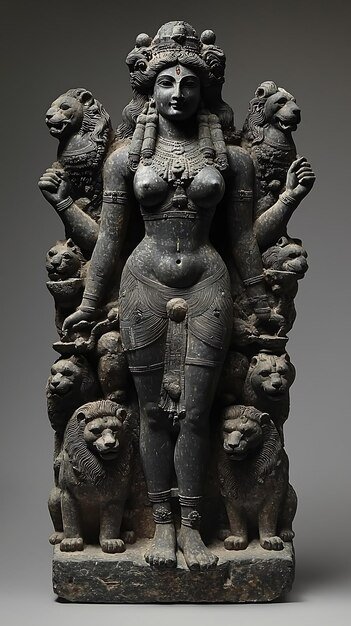
In Hinduism, Devi holds a top spot, especially in the Shakta tradition. The Smarta tradition also recognizes her as one of Brahman’s five main forms. As seen in other traditions, Devi symbolizes the dynamic force of the Deva, always showing up together to complement each other. Examples include Parvati and Shiva, Saraswati and Brahma, Lakshmi and Vishnu, Sita and Rama, and Radha with Krishna.
In numerous Hindu texts like the Devi Upanishad, the teachings echo Devi-centric philosophies. These touch on Shakti, essentially ascribing her the same status as Brahman, the ultimate reality. Shakti stands for both the material world (prakṛti) and consciousness (purusha). The text elaborates her as both joy and non-joy and everything that exists in the universe. Interestingly, Shakti is also identified as Parvati, the wife of Shiva.[23] Furthermore, in texts like the Tripura Upanishad, Bahvricha Upanishad and Guhyakali Upanishad, Shakti is mentioned as Shiva‘s creative power.

Devi, in the Devi Upanishad, claims to be the ultimate truth, Brahman. She tells the gods that she governs the world, enriches believers, and is the highest divinity. All praise should go to her, and she breathes life into everyone. She boldly claims to have built earth and heaven, where she lives.Her making of the sky as a ‘father’ and the waters as the ‘mother’ shows her as the ‘Supreme Inner Self‘.
There’s no superior entity that tells her to create; she is in everything she makes. She-Devi, is infinite, timeless consciousness. She holds earth and heaven and ‘all kinds of joy and sorrow, knowledge and misunderstanding, Brahman and Non-Brahman‘. Utilization of words like yantra, Bindu, bija, mantra, shakti, and chakra as tantric aspects in the Devi Upanishad. She is greatest entity in the entire mythology.



At Modern Puran, we understand the importance of reliable and accessible educational content. Our platform offers a wide range of study materials tailored to various subjects and academic levels, ensuring that students can find exactly what they need to succeed.









© 2024 MODERNPURAN All Rights Reserved